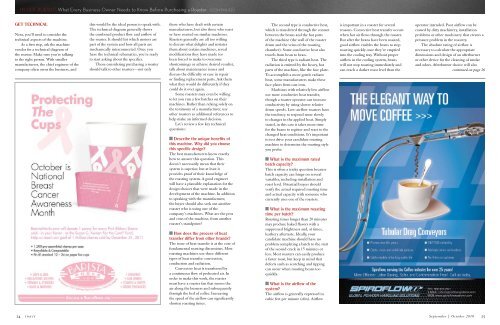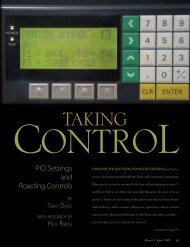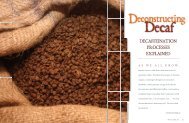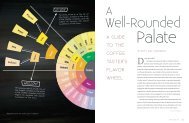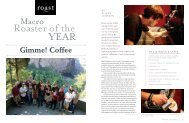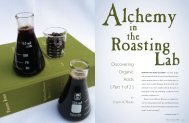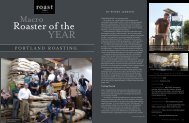In Hot Pursuit - Roast Magazine
In Hot Pursuit - Roast Magazine
In Hot Pursuit - Roast Magazine
Create successful ePaper yourself
Turn your PDF publications into a flip-book with our unique Google optimized e-Paper software.
IN HOT PURSUIT: What Every Business Owner Needs to Know Before Purchasing a <strong>Roast</strong>er (continued)<br />
Get Technical<br />
Next, you’ll need to consider the<br />
technical aspects of the machine.<br />
As a first step, ask the machine<br />
vendor for a technical diagram of<br />
the roaster. Make sure you’re talking<br />
to the right person. With smaller<br />
manufacturers, the chief engineer of the<br />
company often owns the business, and<br />
this would be the ideal person to speak with.<br />
The technical diagram generally shows<br />
the combined product flow and airflow of<br />
the roaster. It should list which motors are<br />
part of the system and how all parts are<br />
mechanically interconnected. Once you<br />
have the technical schematics, you’re ready<br />
to start asking about the specifics.<br />
Those considering purchasing a roaster<br />
should talk to other roasters—not only<br />
those who have dealt with certain<br />
manufacturers, but also those who roast<br />
or have roasted on similar machines.<br />
<strong>Roast</strong>ers generally are all too willing<br />
to discuss what delights and irritates<br />
them about certain machines, reveal<br />
modifications they have made (or<br />
been forced to make to overcome<br />
shortcomings or achieve desired results),<br />
talk about maintenance issues and<br />
discuss the difficulty or ease in repair<br />
or finding replacement parts. Ask them<br />
what they would do differently if they<br />
could do it over again.<br />
Some roasters may even be willing<br />
to let you run a few batches on their<br />
machines. Rather than relying solely on<br />
the testimony of a manufacturer, use<br />
other roasters as additional references to<br />
help make an informed decision.<br />
Let’s review a few key technical<br />
questions:<br />
Describe the unique benefits of<br />
this machine. Why did you choose<br />
this specific design?<br />
The best manufacturers know exactly<br />
how to answer this question. This<br />
doesn’t necessarily mean that their<br />
system is superior, but at least it<br />
provides proof of their knowledge of<br />
the roasting system. A good engineer<br />
will have a plausible explanation for the<br />
design choices that were made in the<br />
development of the machine. <strong>In</strong> addition<br />
to speaking with the manufacturer,<br />
the buyer should also seek out another<br />
roaster who is using one of the<br />
company’s machines. What are the pros<br />
and cons of the machine, from another<br />
roaster’s standpoint?<br />
How does the process of heat<br />
transfer differ from other brands?<br />
The issue of heat transfer is at the core of<br />
fundamental roasting discussions. Most<br />
roasting machines use three different<br />
types of heat transfer: convection,<br />
conduction and radiation.<br />
Convective heat is transferred by<br />
a continuous flow of preheated air. <strong>In</strong><br />
order to make this work, the roaster<br />
must have a roaster fan that moves the<br />
air along the burners and subsequently<br />
through the bed of coffee. <strong>In</strong>creasing<br />
the speed of the airflow can significantly<br />
shorten roasting times.<br />
The second type is conductive heat,<br />
which is transferred through the contact<br />
between the beans and the hot parts<br />
of the machine (the wall of the roaster<br />
drum and the veins of the roasting<br />
chamber). Some conductive heat also<br />
travels from bean to bean.<br />
The third type is radiant heat. The<br />
radiation is emitted by the heavy, hot<br />
parts of the machine, like the face plate.<br />
To accomplish a more gentle radiant<br />
heat, some manufacturers make these<br />
face plates from cast iron.<br />
Machines with relatively low airflow<br />
use more conductive heat transfer,<br />
though a roaster operator can increase<br />
conductivity by using slower relative<br />
drum speeds. Low-airflow roasters have<br />
the tendency to respond more slowly<br />
to changes in the applied heat. Simply<br />
stated, in this case it takes more time<br />
for the beans to register and react to the<br />
changed heat conditions. It’s important<br />
to test drive your candidate roasting<br />
machine to determine the roasting style<br />
you prefer.<br />
What is the maximum rated<br />
batch capacity?<br />
This is often a tricky question because<br />
batch capacity can hinge on several<br />
variables, including installation and<br />
roast level. Potential buyers should<br />
verify the actual required roasting time<br />
and actual capacity with someone who<br />
currently uses one of the roasters.<br />
What is the maximum roasting<br />
time per batch?<br />
<strong>Roast</strong>ing times longer than 20 minutes<br />
may produce baked flavors with a<br />
suppressed brightness and, at times,<br />
leathery aftertaste. Ideally, your<br />
candidate machine should have no<br />
problem completing a batch to the start<br />
of the second crack in 15 minutes or<br />
less. Most roasters can easily produce<br />
a faster roast, but keep in mind that<br />
defects such as scorching and tipping<br />
can occur when roasting beans too<br />
quickly.<br />
What is the airflow of the<br />
system?<br />
The airflow is generally expressed in<br />
cubic feet per minute (cfm). Airflow<br />
is important in a roaster for several<br />
reasons. Convective heat transfer occurs<br />
when hot air flows through the roaster.<br />
But after the beans have been roasted,<br />
good airflow enables the beans to stop<br />
roasting quickly once they’re emptied<br />
into the cooling tray. Without proper<br />
airflow in the cooling system, beans<br />
will not stop roasting immediately and<br />
can reach a darker roast level than the<br />
operator intended. Poor airflow can be<br />
caused by dirty machinery, installation<br />
problems or other machinery that creates a<br />
pressure problem in the roastery.<br />
The absolute rating of airflow is<br />
necessary to calculate the appropriate<br />
dimensions and design of an afterburner<br />
or other device for the cleaning of smoke<br />
and odors. Afterburner choice will also<br />
continued on page 26<br />
24 roast September | October 2010 25


